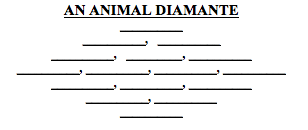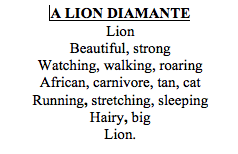Lesson 1: Animals Around Us
Jump To
Print this Page
Additional Resources
Objectives
- The students will understand that they share their environment with many other animals and will be able to identify many of them.
- The students will understand what biodiversity is.
Background
Animals come in many shapes and sizes, inhabit different places, and live in different ways. Biodiversity is the term that describes the many different species sharing one habitat. Understanding what makes a species special and where and how it lives are important if people are to learn to conserve and co-exist with wildlife.
Materials
- Notebooks and pencils
- Colored pencils
- Unlined index cards
Vocabulary
- Biodiversity: the many different species sharing one habitat
Procedure
1. Divide students into several small groups. Have one person (teacher) in each group be the recorder. In his/her notebook, he/she should make the following headings across the top of the page:
- Domestic or wild
- Alone or with others
- Size of group
- Activity
Animal species names can be written in a column on the left side of the page. Each heading should be completed for each species.
2. Take the students outside and have them list all the animals that they see. The recorder will write down all the species the students name and each individual or group that they see. Try to include domestic and wild animals, if possible. Have them include not just mammals, but also birds, amphibians, and reptiles, if possible.
3. Go back inside the classroom and make one list of every species that was seen by the students.
4. Each student in each group should choose one animal that is on the list and be responsible to total the number of animals seen and complete the categories listed above. By totaling these for all the groups, your list will tell you a great deal about the animals the class observed today. Have someone copy down all of the data collected today for later use.
5. Pass out one card to each student and have him/her draw and name the animal they chose. Let children use pictures of animals, field guides, and other books if needed. Save these cards for future activities.
Questions for Discussion
- How many different species were seen?
- Which animals were the most common? Do you think there are more of these, or are they just easier for you to see?
- What activities were observed? Were different species doing the same activities?
- Are any of these species used by people? How?
Extended Activities
1. Diversity By Habitat
If possible, do this activity a second time in another area where other species may be seen. Discuss which habitat had more biodiversity and why habitats may differ in biodiversity.
2. Wild and Domestic Animals
Using the cards the students drew, separate into two piles, one of wild animals, one of domestic. Discuss their similarities and differences. Then have students draw scenes where wild animals would be found and scenes where domestic animals would be found.
3. What Animal Am I?
Clip a picture of an animal on the back of a student. The student turns around so the other students can look at it. Then the student asks questions to find out what the animal is. Talk as a group first about the kinds of questions to ask:
- What it eats.
- Where it lives.
- What it looks like. These would include its size, coloration, number of feet, etc.
Suggestions:
- For younger children, ask questions like, Do I fly, swim, or run? Do I eat grass, insects, or small mammals? How many legs do I have? For older children, ask questions that can only be answered by yes or no (or maybe), such as Do I have four legs? Am I smaller than a chair? Can I fly?
- The group can be broken into smaller groups so that more people get to play the game.
4. ABC Book of Species
Make an alphabet book of animal species. Have each child draw an animal for a letter of the alphabet and write a description of it. Put together as a book.
5. Animal Diamante
A poem that has seven lines and does not rhyme is called a diamante poem. It also gets its name from the diamond shape made up of the seven lines.

Create your own animal poem using the following directions:
Line 1: Write the name of an animal (a noun).
Line 2: Write two words describing an animal (adjectives).
Line 3: Write three action words ending in “ing” (verbs).
Line 4: Write four words that relate to the animal such as its color or what it eats or where it lives.
Line 5: Write three more action words that end in “ing” (verbs).
Line 6: Write two words describing the animal (adjectives).
Line 7: Write one word (noun or the animal’s name). Write either the name of the animal or a synonym for the noun.
Helpful hints: Look at pictures or read about the animal you have chosen for your poem. You may even want to observe the animal first before doing your poem. Make a list of words that are related to the animal such as nouns, adjectives, verbs, and synonyms. Begin each line with a capital letter and place a comma after each word.

6. The Spice of Life
This activity gives secondary students the opportunity to understand and explain their beliefs about protecting biodiversity. Teacher writes the following six statements (and an ”Other Reason” category) on large paper and hangs in six areas around the room. Each student decides which statement best answers the question “Why Care About Biodiversity?” and stands next to it. Students are then asked to explain their choices using prompts to guide discussion about their values in regards to nature and protecting biodiversity.
1. It is important to conserve the diversity of life to provide communities with useful products. Plants and animals could provide us with additional foods, medicines, and other products that will save lives and benefit our community.
2. It is important to protect the diversity of life because biodiversity helps maintain important life and systems processes such as oxygen production, pollination, and flood control that, in turn, help support all life on Earth.
3. Our lives would not be as rich if we lost species such as Grevy’s zebra, beetles, hawks, frogs, lizards, lions, and leopards and the habitats where they live. The rich diversity of life also allows for important recreational activities such as walking safaris, game viewing/watching, game-bird shooting, camping, and bird-watching. (Many of these activities are part of ecotourism).
4. It is important to protect the diversity of life because no generation has the right to destroy the environment and resources on which future generations depend. It is our responsibility to take care of the diversity of life for future generations.
5. It is important to protect the diversity of life as it provides inspiration and provokes curiosity and imagination. Art, music, and poetry are often inspired by Earth’s diversity. And many of our technological advances, such as flight, have been inspired by nature.
6. It is important to protect the diversity of life because all species have a right to exist. Humans are not the supreme deity that should determine the fate of other inhabitants on our plant, but are just one member of the incredible assemblage of life on Earth.
